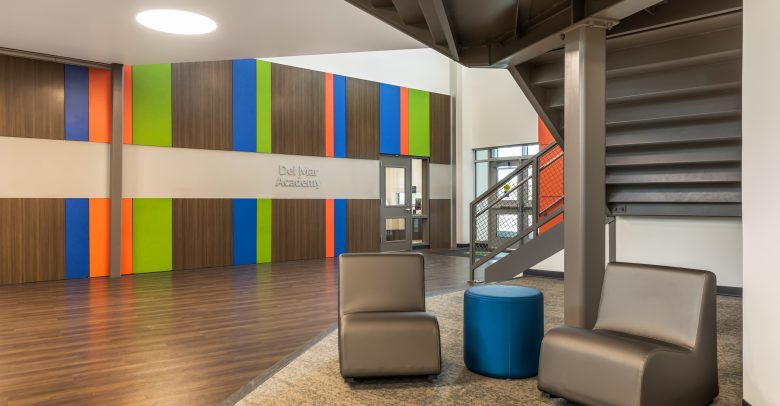VIDEO: Clean Air – Three Rings of Protection for Schools
Clean air is essential to combat airborne viruses and keep schools healthy. Layered protection refers to the use of multiple systems (each deployed at a different level) to safeguard against potential threats. Discover our three-layered strategy to protect staff and students from threats posed by airborne pathogens.
In terms of physical security at school sites, could you envision a school relying solely on a physical fence? Or building cameras? Or security personnel? Or solely on controlled ingress/egress points? Probably not. In fact, districts and school sites rely on multiple measures to build layers of physical protection for schools and the school community inside: teachers, staff, administrators, parents, and students.
Layered protection refers to the use of multiple systems (each deployed at a different level) to safeguard against potential threats. If a threat manages to breach an outer layer of security, there are additional inner layers in place to capture or contain the threat.
We believe school districts can employ this same mindset, this same layered protection strategy as with physical security, to combating the microbial and microscopic threats posed by airborne pathogens: particulates, smoke, bacteria, and viruses like SARS-CoV-2 and influenza.
This article speaks to why clean air is essential to combating an airborne virus threat from SARS-CoV-2, and it describes a three-layered approach, what we call concentric rings of defense, to addressing this challenge.
Circulating clean air is critical
A recent New York Times article, done in consultation with experts like the T.H. Chan School of Public Health at Harvard University and others, noted that ventilation is a key element to reopening schools safely, even if students remain socially distanced. As a simulation created by the newspaper demonstrates, about 3 percent of the air that each person breathes in a classroom containing 10 people was exhaled by others, even if they are all wearing masks.
If even one of these students or the teacher is infected with COVID-19, then he or she is spreading contaminants just by breathing. With little fresh air coming into the space, these contaminants will continue to circulate throughout the room, as the simulation clearly demonstrates.
To keep school communities safe, Dr. Joseph Allen, assistant professor of exposure assessment science and director of the Healthy Buildings Program at the T.H. Chan School of Public Health, recommends three air changes per hour at a minimum within a classroom. Four air changes is good. Five is excellent. Six is ideal. Because of several exogenous factors, schools are falling well short of this mark, however, even as they are reopening their doors to students.
Many schools have decades-old heating, ventilation, and air conditioning (HVAC) systems that will do little to mitigate the spread of COVID-19 or other viruses. For instance, a recent Chalkbeat analysis of HVAC data that 285 Michigan schools submitted to the state reveals that few of those schools have filters capable of removing viral particles from the air. In more than a quarter of the schools, the HVAC systems have not been updated in at least 20 years.
The evidence continues to mount demonstrating that indoor air quality (IAQ) directly impacts student academic performance and health. IAQ refers to those characteristics of the air in indoor environments—such as levels of pollutants, humidity, and temperature—that impact the occupants’ health, comfort, and ability to perform. Children are inherently more vulnerable to environmental hazards because their bodies are still developing. Substandard environmental conditions in schools, such as insufficient cleaning or inadequate ventilation, can cause serious health problems for children, according to research done in conjunction with the Environmental Protection Agency (EPA).
Deploying concentric rings of defense
School leaders can use many methods to clean the air inside their buildings. But as with any defense system, a multilayered approach is the best way to ensure success.
For air filtration and purification, we recommend tackling the problem at three key levels, or concentric rings of defense. The first ring of defense, the outer ring, is within the main air handling unit (AHU) or HVAC system on a building’s roof. The second ring, the middle ring, is inside the yards of galvanized ventilation ductwork that facilitates air circulation throughout the school building. And the final ring, the inner ring, is within classrooms themselves.
Here is a closer look at each of these defenses.
At the HVAC level: Within the AHU, in addition to upgrading MERV filters, schools can employ a combination of UV-C light and photocatalytic oxidation (PCO) technology to reduce the spread of particulates, smoke, bacteria, and viruses like SARS-CoV-2 and influenza. (For an explanation of why these three technologies working in conjunction with each other are effective, see this previous article.)
The goal is to capture and deactivate as many microscopic particulates, bacteria, and viruses as possible as air is introduced into the HVAC system, before they have an opportunity to multiply. Another significant benefit to using UV-C light placed at or near the AC coils is its effect in keeping the coils clean from mold and toxic biofilm, allowing the coils to operate more efficiently. This reduces school site energy costs, as well as recurring maintenance, cleaning, and servicing costs. It also extends the useful life of the coils. Solutions that can be deployed at this outer ring of defense include the Field Controls Cube and FlexMountUV, both distributed by School Specialty.
Inside the ductwork: Bacteria, viruses, and other pathogens are introduced into the building by its occupants and often cannot be controlled at the source. Therefore, it’s important to attack these airborne invaders early and often. The use of UV-C light inside the ductwork has been shown to reduce airborne contaminants and provides a further layer of defense, killing or deactivating viruses and bacteria that make it past the outer ring of defense. Solutions that can be deployed inside the ductwork include the Field Controls Duo line of products distributed by School Specialty.
Within classrooms: This inner ring of defense includes solutions for preserving clean and healthy air inside the classroom, as well as techniques for disinfecting classrooms and the tools, instruments, and equipment that students and teachers are using for instruction.
UV-C robots provide a fast, safe, and highly effective alternative to the practice of electrostatic spraying of chemicals for classroom disinfection. What’s more, the use of UV-C robots can save a school district millions of dollars in recurring operating expenses. In our analysis, a district with 13 sites could save approximately $2 million, a district with 93 sites could save approximately $16 million, and a district with 330 sites could save approximately $51 million annually, by redirecting its spend on chemicals to the ownership (or lease) and utilization of UV-C robots for school site disinfecting.
Further, a move away from chemicals to a safe and proven alternative like UV-C robots, which are routinely used in hospitals and other applications, could be welcomed relief to students, parents, teachers, staff, and administrators who suffer from asthma and other respiratory ailments. This consideration should not be taken lightly—about 10 percent of our nation’s student population suffer from asthma, according to the American Lung Association. The CDC writes in one of its most recent publications providing guidance to schools and teachers, “Disinfectants can trigger an asthma attack. Choose safer products if students in the class have asthma.”
The ADIBOT-S robot from UBTECH, distributed by School Specialty, uses UV-C germicidal lamps to irradiate the air and surfaces within a typical classroom or nurses office, in less than three minutes. A typical-sized school cafeteria can be irradiated in about 15 minutes or less.
Portable air purifiers, such as the Field Controls TRIO Plus and Trio Pro, distributed by School Specialty, employ UV-C, Field Controls’ patented Pro-CellTM PCO technology, and HEPA13 multi-stage filters to help keep the air within classrooms, libraries, gyms, multi-purpose rooms, makerspaces, and offices clean while students, teachers, and staff are present in the rooms. These air purifier solutions meet the minimum three air changes per hour (ACH) guidance of the Healthy Buildings Program.
UV-C cabinets, like the Copernicus UV Tech Tub distributed by School Specialty, use ultraviolet lamps that bathe items inside with 360 degrees of germicidal light, effectively killing 99 percent of viruses and other germs in one minute. This allows educators to disinfect tools, instruments, phones, laptops, and equipment between class periods, so the next class of students can use them safely.
CO2 monitors in schools are quite common in Europe and are only just starting to see widespread adoption by schools here in America. Because CO2 is exhaled as people breathe, it can serve as a proxy for how much exhaled air—and thus, how much possible airborne virus—has accumulated. Outdoors, the CO2 concentration is about 400 parts per million (ppm). Indoor CO2 levels in schools should be kept below 700 ppm, even if everyone is wearing a mask, according to Jose-Luis Jimenez, an aerosol scientist at the University of Colorado at Boulder who models transmission risks. School Specialty distributes several CO2 monitors from Honeywell, IPVideo Corp, and ACI.
A smart, strategic investment for today…and tomorrow
Providing concentric rings of protection against airborne pathogens like the coronavirus transmission within school buildings obviously comes a cost. However, the $1.9 trillion coronavirus relief measure signed into law by President Biden in March provides $126 billion to help K-12 schools reopen safely. This is on top of the two rounds of funding for elementary and secondary schools that were passed into law last year, which total nearly $67 billion.
These financial outlays represent a long-term strategic investment in keeping school communities safe and healthy today and tomorrow.
In addition to the other important protective actions taken by schools—like social distancing, temperature screening, hand washing, desk shields, mask wearing, and cohorting, to name a few—providing for multiple layers of protection through concentric rings of defense that involve cleaning and purifying the air at the HVAC, ductwork, and classroom levels is a smart way to protect staff and students not only from the current pandemic but from future airborne pathogen threats as well.
This article also appeared on District Administration.
Michael Crumlin
Mike Crumlin “MAC” leads the business development activity for School Specialty. A product of Prince George’s County Public schools, MAC is a graduate of West Point and the Harvard Business School. After service as an Army officer and special operations pilot, he pursued a 25-year career in high tech, most of it in Silicon Valley. MAC first sought to serve school-aged children when he stood for and won a House seat to the Maryland General Assembly. Today, in his role with School Specialty, MAC seeks to serve school districts and school-aged children, and pay homage to his parents, who were both 30-year veterans of the D.C. Public School System.
Read more posts by Michael Crumlin–>







Leave a Reply